Capital Structure Theories and Association with Firms' Value - BAO5534
VerifiedAdded on 2023/06/03
|11
|3463
|220
Report
AI Summary
This report delves into the critical aspects of capital structure theory, examining its influence on firm value. It begins by outlining the core concepts and the importance of determining an optimal capital structure to enhance returns and minimize the cost of capital. The report then explores various theories, including the Modigliani-Miller (MM) theory, agency cost theory, and the trade-off theory, highlighting their assumptions, strengths, and limitations. It discusses the debate around whether an optimal capital structure exists and the impact of debt-to-equity ratios. The report also analyzes the agency problems that arise between managers, shareholders, and debt holders, and how these conflicts impact capital structure decisions. Furthermore, it examines the role of financial leverage, tax benefits, and market conditions in shaping capital structure choices. The report provides a comprehensive analysis of how these factors collectively influence a firm's value and financial performance.
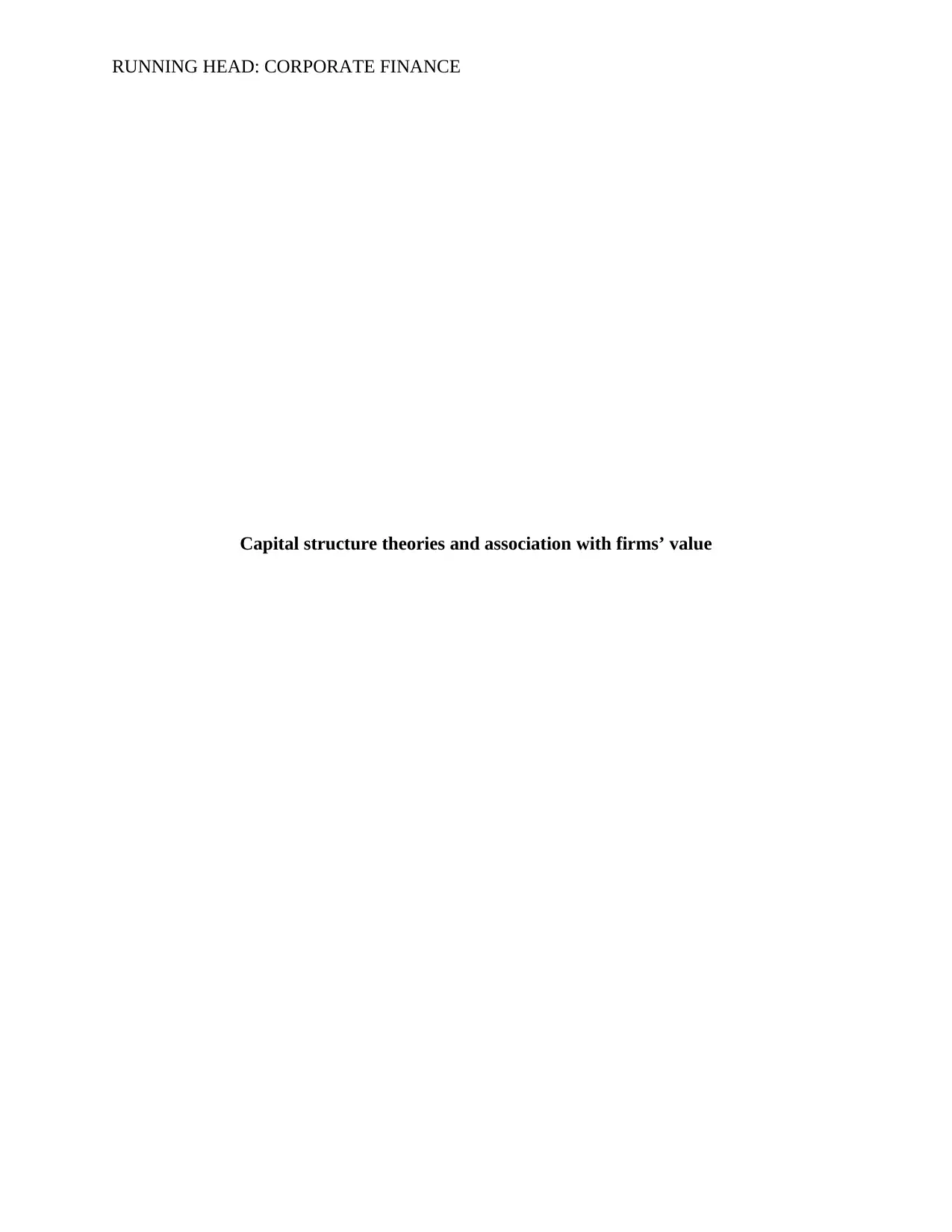
RUNNING HEAD: CORPORATE FINANCE
Capital structure theories and association with firms’ value
Capital structure theories and association with firms’ value
Paraphrase This Document
Need a fresh take? Get an instant paraphrase of this document with our AI Paraphraser
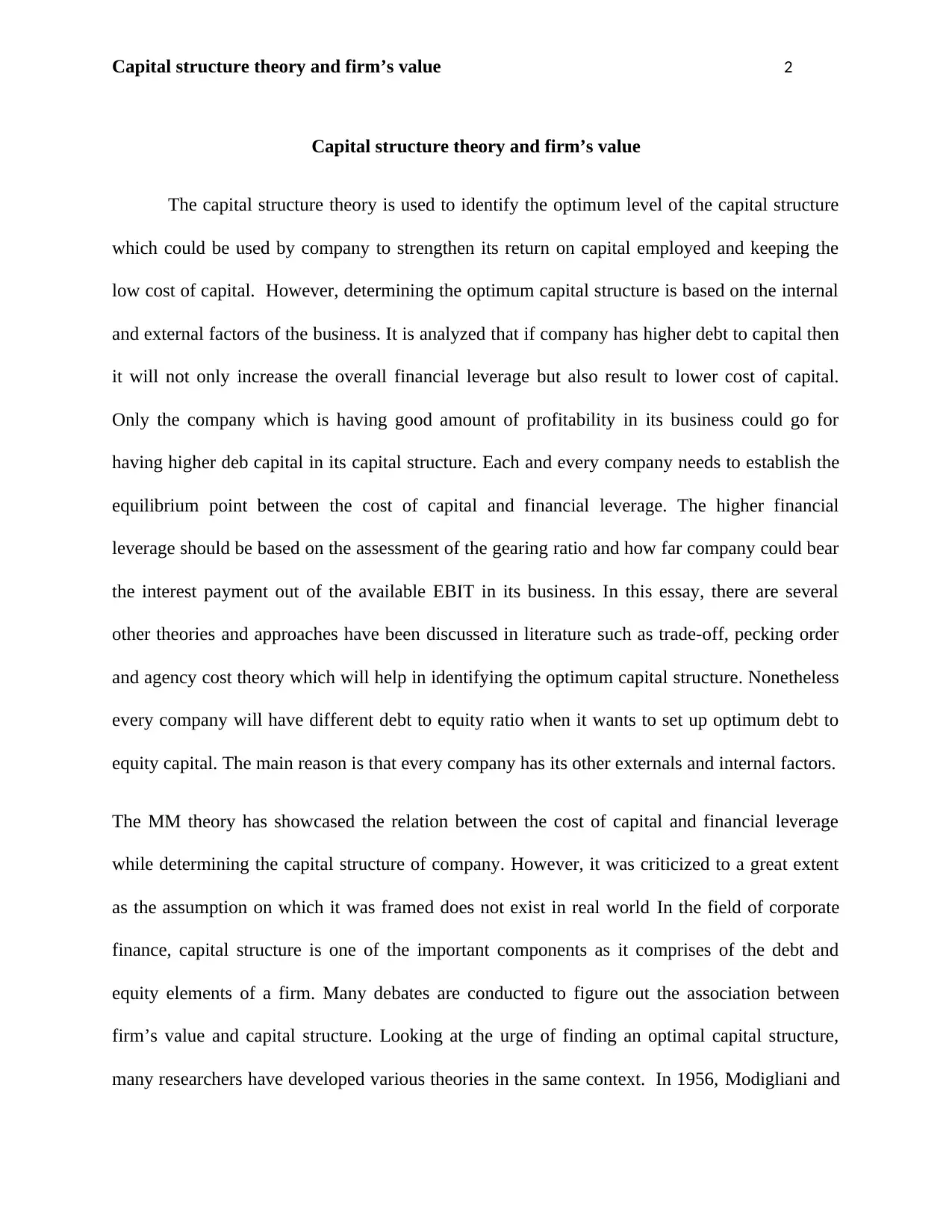
Capital structure theory and firm’s value 2
Capital structure theory and firm’s value
The capital structure theory is used to identify the optimum level of the capital structure
which could be used by company to strengthen its return on capital employed and keeping the
low cost of capital. However, determining the optimum capital structure is based on the internal
and external factors of the business. It is analyzed that if company has higher debt to capital then
it will not only increase the overall financial leverage but also result to lower cost of capital.
Only the company which is having good amount of profitability in its business could go for
having higher deb capital in its capital structure. Each and every company needs to establish the
equilibrium point between the cost of capital and financial leverage. The higher financial
leverage should be based on the assessment of the gearing ratio and how far company could bear
the interest payment out of the available EBIT in its business. In this essay, there are several
other theories and approaches have been discussed in literature such as trade-off, pecking order
and agency cost theory which will help in identifying the optimum capital structure. Nonetheless
every company will have different debt to equity ratio when it wants to set up optimum debt to
equity capital. The main reason is that every company has its other externals and internal factors.
The MM theory has showcased the relation between the cost of capital and financial leverage
while determining the capital structure of company. However, it was criticized to a great extent
as the assumption on which it was framed does not exist in real world In the field of corporate
finance, capital structure is one of the important components as it comprises of the debt and
equity elements of a firm. Many debates are conducted to figure out the association between
firm’s value and capital structure. Looking at the urge of finding an optimal capital structure,
many researchers have developed various theories in the same context. In 1956, Modigliani and
Capital structure theory and firm’s value
The capital structure theory is used to identify the optimum level of the capital structure
which could be used by company to strengthen its return on capital employed and keeping the
low cost of capital. However, determining the optimum capital structure is based on the internal
and external factors of the business. It is analyzed that if company has higher debt to capital then
it will not only increase the overall financial leverage but also result to lower cost of capital.
Only the company which is having good amount of profitability in its business could go for
having higher deb capital in its capital structure. Each and every company needs to establish the
equilibrium point between the cost of capital and financial leverage. The higher financial
leverage should be based on the assessment of the gearing ratio and how far company could bear
the interest payment out of the available EBIT in its business. In this essay, there are several
other theories and approaches have been discussed in literature such as trade-off, pecking order
and agency cost theory which will help in identifying the optimum capital structure. Nonetheless
every company will have different debt to equity ratio when it wants to set up optimum debt to
equity capital. The main reason is that every company has its other externals and internal factors.
The MM theory has showcased the relation between the cost of capital and financial leverage
while determining the capital structure of company. However, it was criticized to a great extent
as the assumption on which it was framed does not exist in real world In the field of corporate
finance, capital structure is one of the important components as it comprises of the debt and
equity elements of a firm. Many debates are conducted to figure out the association between
firm’s value and capital structure. Looking at the urge of finding an optimal capital structure,
many researchers have developed various theories in the same context. In 1956, Modigliani and
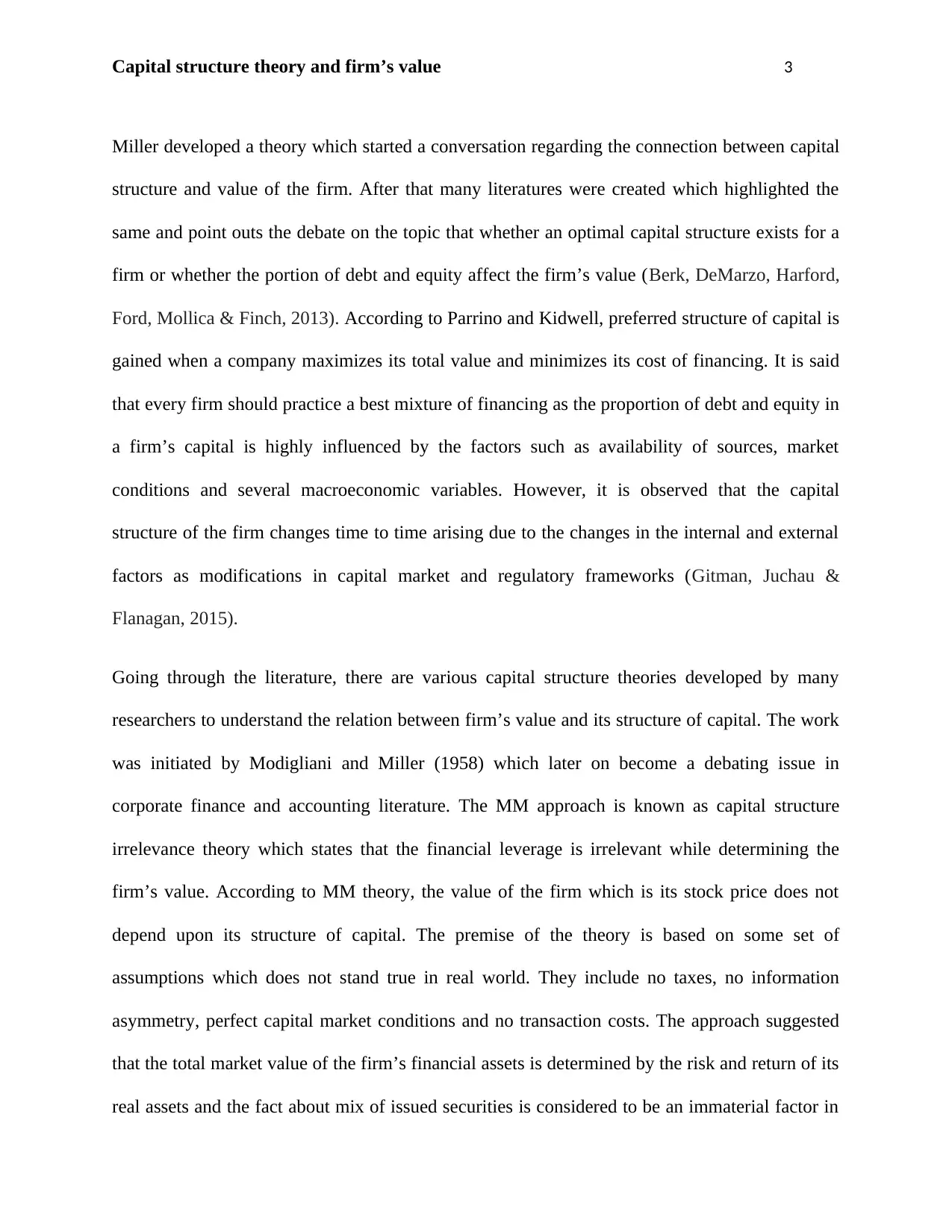
Capital structure theory and firm’s value 3
Miller developed a theory which started a conversation regarding the connection between capital
structure and value of the firm. After that many literatures were created which highlighted the
same and point outs the debate on the topic that whether an optimal capital structure exists for a
firm or whether the portion of debt and equity affect the firm’s value (Berk, DeMarzo, Harford,
Ford, Mollica & Finch, 2013). According to Parrino and Kidwell, preferred structure of capital is
gained when a company maximizes its total value and minimizes its cost of financing. It is said
that every firm should practice a best mixture of financing as the proportion of debt and equity in
a firm’s capital is highly influenced by the factors such as availability of sources, market
conditions and several macroeconomic variables. However, it is observed that the capital
structure of the firm changes time to time arising due to the changes in the internal and external
factors as modifications in capital market and regulatory frameworks (Gitman, Juchau &
Flanagan, 2015).
Going through the literature, there are various capital structure theories developed by many
researchers to understand the relation between firm’s value and its structure of capital. The work
was initiated by Modigliani and Miller (1958) which later on become a debating issue in
corporate finance and accounting literature. The MM approach is known as capital structure
irrelevance theory which states that the financial leverage is irrelevant while determining the
firm’s value. According to MM theory, the value of the firm which is its stock price does not
depend upon its structure of capital. The premise of the theory is based on some set of
assumptions which does not stand true in real world. They include no taxes, no information
asymmetry, perfect capital market conditions and no transaction costs. The approach suggested
that the total market value of the firm’s financial assets is determined by the risk and return of its
real assets and the fact about mix of issued securities is considered to be an immaterial factor in
Miller developed a theory which started a conversation regarding the connection between capital
structure and value of the firm. After that many literatures were created which highlighted the
same and point outs the debate on the topic that whether an optimal capital structure exists for a
firm or whether the portion of debt and equity affect the firm’s value (Berk, DeMarzo, Harford,
Ford, Mollica & Finch, 2013). According to Parrino and Kidwell, preferred structure of capital is
gained when a company maximizes its total value and minimizes its cost of financing. It is said
that every firm should practice a best mixture of financing as the proportion of debt and equity in
a firm’s capital is highly influenced by the factors such as availability of sources, market
conditions and several macroeconomic variables. However, it is observed that the capital
structure of the firm changes time to time arising due to the changes in the internal and external
factors as modifications in capital market and regulatory frameworks (Gitman, Juchau &
Flanagan, 2015).
Going through the literature, there are various capital structure theories developed by many
researchers to understand the relation between firm’s value and its structure of capital. The work
was initiated by Modigliani and Miller (1958) which later on become a debating issue in
corporate finance and accounting literature. The MM approach is known as capital structure
irrelevance theory which states that the financial leverage is irrelevant while determining the
firm’s value. According to MM theory, the value of the firm which is its stock price does not
depend upon its structure of capital. The premise of the theory is based on some set of
assumptions which does not stand true in real world. They include no taxes, no information
asymmetry, perfect capital market conditions and no transaction costs. The approach suggested
that the total market value of the firm’s financial assets is determined by the risk and return of its
real assets and the fact about mix of issued securities is considered to be an immaterial factor in
⊘ This is a preview!⊘
Do you want full access?
Subscribe today to unlock all pages.

Trusted by 1+ million students worldwide
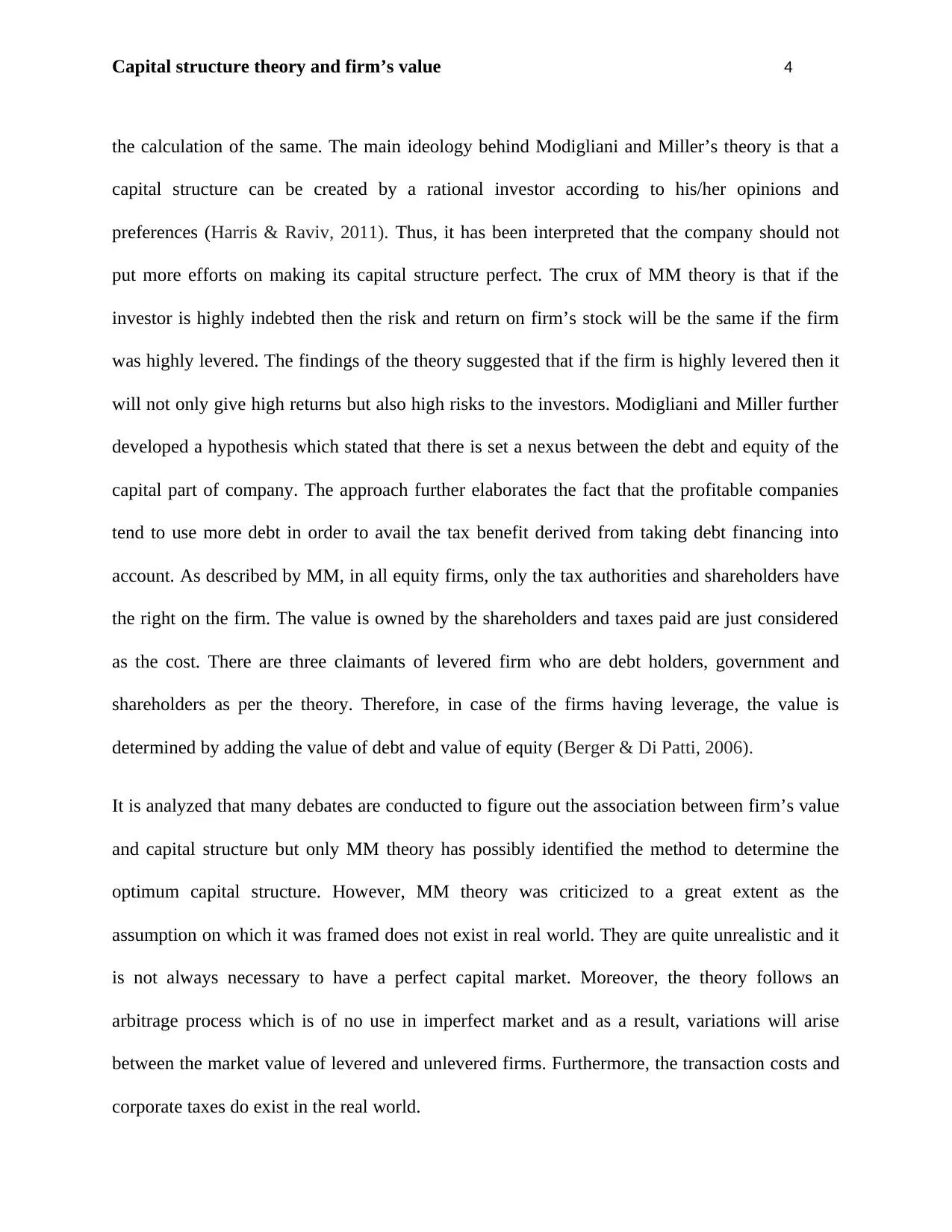
Capital structure theory and firm’s value 4
the calculation of the same. The main ideology behind Modigliani and Miller’s theory is that a
capital structure can be created by a rational investor according to his/her opinions and
preferences (Harris & Raviv, 2011). Thus, it has been interpreted that the company should not
put more efforts on making its capital structure perfect. The crux of MM theory is that if the
investor is highly indebted then the risk and return on firm’s stock will be the same if the firm
was highly levered. The findings of the theory suggested that if the firm is highly levered then it
will not only give high returns but also high risks to the investors. Modigliani and Miller further
developed a hypothesis which stated that there is set a nexus between the debt and equity of the
capital part of company. The approach further elaborates the fact that the profitable companies
tend to use more debt in order to avail the tax benefit derived from taking debt financing into
account. As described by MM, in all equity firms, only the tax authorities and shareholders have
the right on the firm. The value is owned by the shareholders and taxes paid are just considered
as the cost. There are three claimants of levered firm who are debt holders, government and
shareholders as per the theory. Therefore, in case of the firms having leverage, the value is
determined by adding the value of debt and value of equity (Berger & Di Patti, 2006).
It is analyzed that many debates are conducted to figure out the association between firm’s value
and capital structure but only MM theory has possibly identified the method to determine the
optimum capital structure. However, MM theory was criticized to a great extent as the
assumption on which it was framed does not exist in real world. They are quite unrealistic and it
is not always necessary to have a perfect capital market. Moreover, the theory follows an
arbitrage process which is of no use in imperfect market and as a result, variations will arise
between the market value of levered and unlevered firms. Furthermore, the transaction costs and
corporate taxes do exist in the real world.
the calculation of the same. The main ideology behind Modigliani and Miller’s theory is that a
capital structure can be created by a rational investor according to his/her opinions and
preferences (Harris & Raviv, 2011). Thus, it has been interpreted that the company should not
put more efforts on making its capital structure perfect. The crux of MM theory is that if the
investor is highly indebted then the risk and return on firm’s stock will be the same if the firm
was highly levered. The findings of the theory suggested that if the firm is highly levered then it
will not only give high returns but also high risks to the investors. Modigliani and Miller further
developed a hypothesis which stated that there is set a nexus between the debt and equity of the
capital part of company. The approach further elaborates the fact that the profitable companies
tend to use more debt in order to avail the tax benefit derived from taking debt financing into
account. As described by MM, in all equity firms, only the tax authorities and shareholders have
the right on the firm. The value is owned by the shareholders and taxes paid are just considered
as the cost. There are three claimants of levered firm who are debt holders, government and
shareholders as per the theory. Therefore, in case of the firms having leverage, the value is
determined by adding the value of debt and value of equity (Berger & Di Patti, 2006).
It is analyzed that many debates are conducted to figure out the association between firm’s value
and capital structure but only MM theory has possibly identified the method to determine the
optimum capital structure. However, MM theory was criticized to a great extent as the
assumption on which it was framed does not exist in real world. They are quite unrealistic and it
is not always necessary to have a perfect capital market. Moreover, the theory follows an
arbitrage process which is of no use in imperfect market and as a result, variations will arise
between the market value of levered and unlevered firms. Furthermore, the transaction costs and
corporate taxes do exist in the real world.
Paraphrase This Document
Need a fresh take? Get an instant paraphrase of this document with our AI Paraphraser
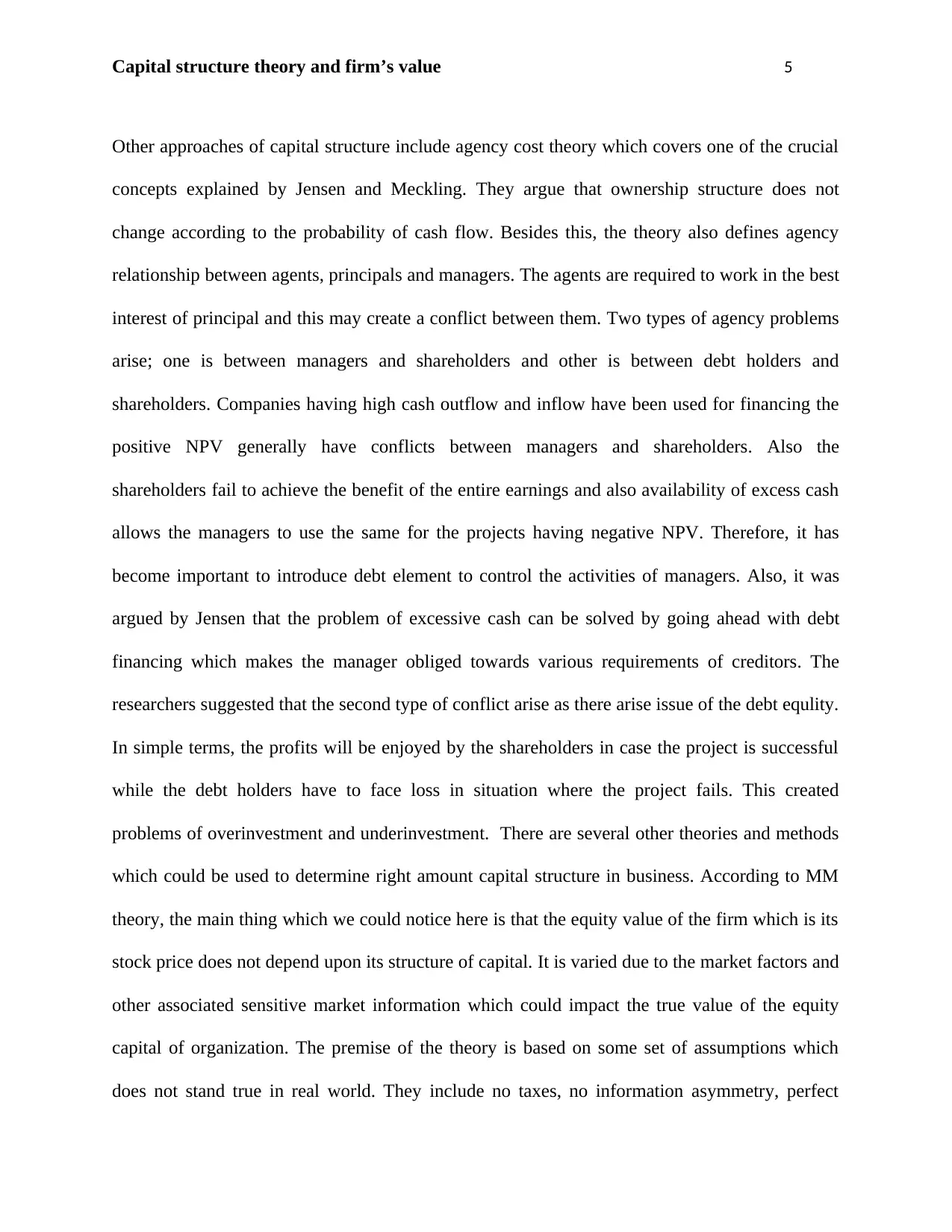
Capital structure theory and firm’s value 5
Other approaches of capital structure include agency cost theory which covers one of the crucial
concepts explained by Jensen and Meckling. They argue that ownership structure does not
change according to the probability of cash flow. Besides this, the theory also defines agency
relationship between agents, principals and managers. The agents are required to work in the best
interest of principal and this may create a conflict between them. Two types of agency problems
arise; one is between managers and shareholders and other is between debt holders and
shareholders. Companies having high cash outflow and inflow have been used for financing the
positive NPV generally have conflicts between managers and shareholders. Also the
shareholders fail to achieve the benefit of the entire earnings and also availability of excess cash
allows the managers to use the same for the projects having negative NPV. Therefore, it has
become important to introduce debt element to control the activities of managers. Also, it was
argued by Jensen that the problem of excessive cash can be solved by going ahead with debt
financing which makes the manager obliged towards various requirements of creditors. The
researchers suggested that the second type of conflict arise as there arise issue of the debt equlity.
In simple terms, the profits will be enjoyed by the shareholders in case the project is successful
while the debt holders have to face loss in situation where the project fails. This created
problems of overinvestment and underinvestment. There are several other theories and methods
which could be used to determine right amount capital structure in business. According to MM
theory, the main thing which we could notice here is that the equity value of the firm which is its
stock price does not depend upon its structure of capital. It is varied due to the market factors and
other associated sensitive market information which could impact the true value of the equity
capital of organization. The premise of the theory is based on some set of assumptions which
does not stand true in real world. They include no taxes, no information asymmetry, perfect
Other approaches of capital structure include agency cost theory which covers one of the crucial
concepts explained by Jensen and Meckling. They argue that ownership structure does not
change according to the probability of cash flow. Besides this, the theory also defines agency
relationship between agents, principals and managers. The agents are required to work in the best
interest of principal and this may create a conflict between them. Two types of agency problems
arise; one is between managers and shareholders and other is between debt holders and
shareholders. Companies having high cash outflow and inflow have been used for financing the
positive NPV generally have conflicts between managers and shareholders. Also the
shareholders fail to achieve the benefit of the entire earnings and also availability of excess cash
allows the managers to use the same for the projects having negative NPV. Therefore, it has
become important to introduce debt element to control the activities of managers. Also, it was
argued by Jensen that the problem of excessive cash can be solved by going ahead with debt
financing which makes the manager obliged towards various requirements of creditors. The
researchers suggested that the second type of conflict arise as there arise issue of the debt equlity.
In simple terms, the profits will be enjoyed by the shareholders in case the project is successful
while the debt holders have to face loss in situation where the project fails. This created
problems of overinvestment and underinvestment. There are several other theories and methods
which could be used to determine right amount capital structure in business. According to MM
theory, the main thing which we could notice here is that the equity value of the firm which is its
stock price does not depend upon its structure of capital. It is varied due to the market factors and
other associated sensitive market information which could impact the true value of the equity
capital of organization. The premise of the theory is based on some set of assumptions which
does not stand true in real world. They include no taxes, no information asymmetry, perfect
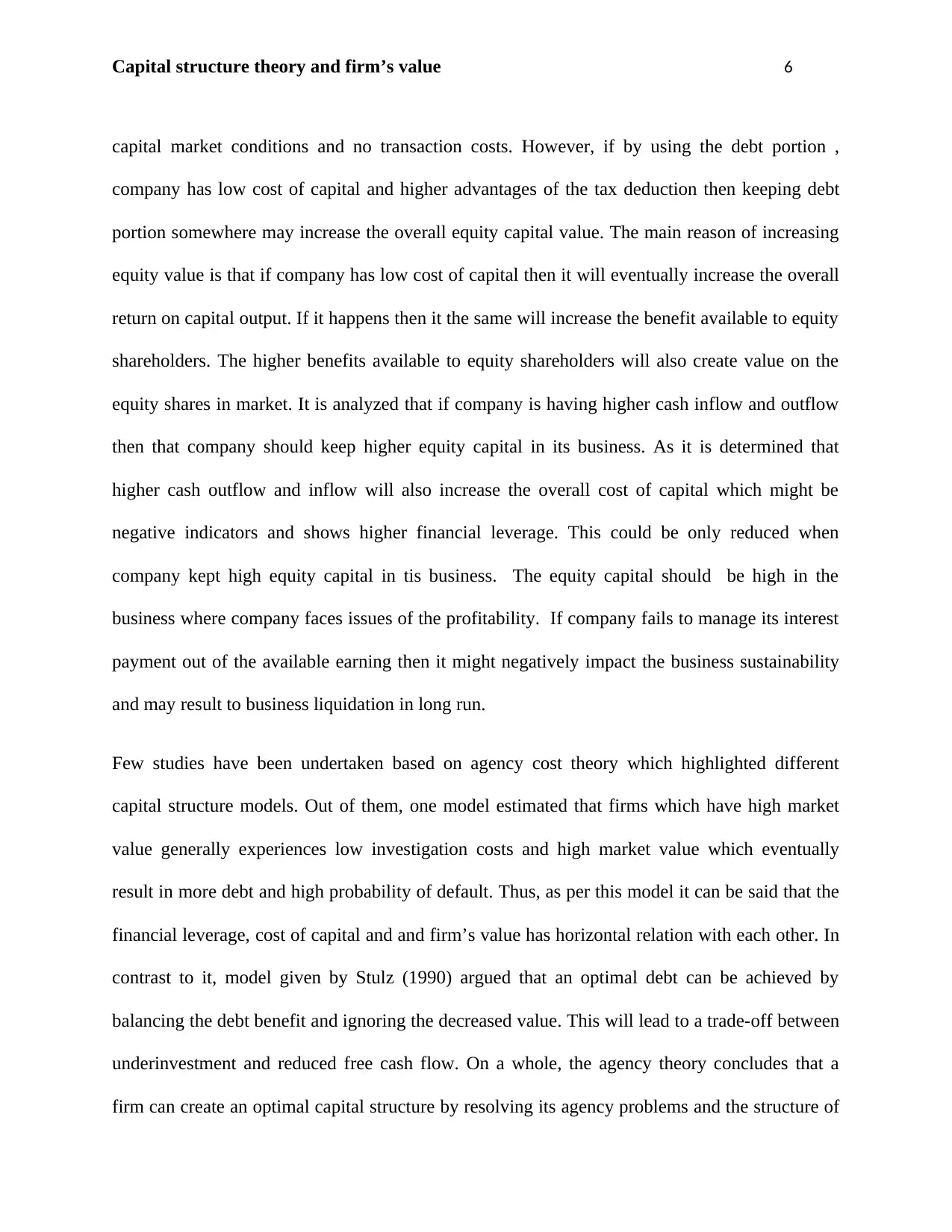
Capital structure theory and firm’s value 6
capital market conditions and no transaction costs. However, if by using the debt portion ,
company has low cost of capital and higher advantages of the tax deduction then keeping debt
portion somewhere may increase the overall equity capital value. The main reason of increasing
equity value is that if company has low cost of capital then it will eventually increase the overall
return on capital output. If it happens then it the same will increase the benefit available to equity
shareholders. The higher benefits available to equity shareholders will also create value on the
equity shares in market. It is analyzed that if company is having higher cash inflow and outflow
then that company should keep higher equity capital in its business. As it is determined that
higher cash outflow and inflow will also increase the overall cost of capital which might be
negative indicators and shows higher financial leverage. This could be only reduced when
company kept high equity capital in tis business. The equity capital should be high in the
business where company faces issues of the profitability. If company fails to manage its interest
payment out of the available earning then it might negatively impact the business sustainability
and may result to business liquidation in long run.
Few studies have been undertaken based on agency cost theory which highlighted different
capital structure models. Out of them, one model estimated that firms which have high market
value generally experiences low investigation costs and high market value which eventually
result in more debt and high probability of default. Thus, as per this model it can be said that the
financial leverage, cost of capital and and firm’s value has horizontal relation with each other. In
contrast to it, model given by Stulz (1990) argued that an optimal debt can be achieved by
balancing the debt benefit and ignoring the decreased value. This will lead to a trade-off between
underinvestment and reduced free cash flow. On a whole, the agency theory concludes that a
firm can create an optimal capital structure by resolving its agency problems and the structure of
capital market conditions and no transaction costs. However, if by using the debt portion ,
company has low cost of capital and higher advantages of the tax deduction then keeping debt
portion somewhere may increase the overall equity capital value. The main reason of increasing
equity value is that if company has low cost of capital then it will eventually increase the overall
return on capital output. If it happens then it the same will increase the benefit available to equity
shareholders. The higher benefits available to equity shareholders will also create value on the
equity shares in market. It is analyzed that if company is having higher cash inflow and outflow
then that company should keep higher equity capital in its business. As it is determined that
higher cash outflow and inflow will also increase the overall cost of capital which might be
negative indicators and shows higher financial leverage. This could be only reduced when
company kept high equity capital in tis business. The equity capital should be high in the
business where company faces issues of the profitability. If company fails to manage its interest
payment out of the available earning then it might negatively impact the business sustainability
and may result to business liquidation in long run.
Few studies have been undertaken based on agency cost theory which highlighted different
capital structure models. Out of them, one model estimated that firms which have high market
value generally experiences low investigation costs and high market value which eventually
result in more debt and high probability of default. Thus, as per this model it can be said that the
financial leverage, cost of capital and and firm’s value has horizontal relation with each other. In
contrast to it, model given by Stulz (1990) argued that an optimal debt can be achieved by
balancing the debt benefit and ignoring the decreased value. This will lead to a trade-off between
underinvestment and reduced free cash flow. On a whole, the agency theory concludes that a
firm can create an optimal capital structure by resolving its agency problems and the structure of
⊘ This is a preview!⊘
Do you want full access?
Subscribe today to unlock all pages.

Trusted by 1+ million students worldwide
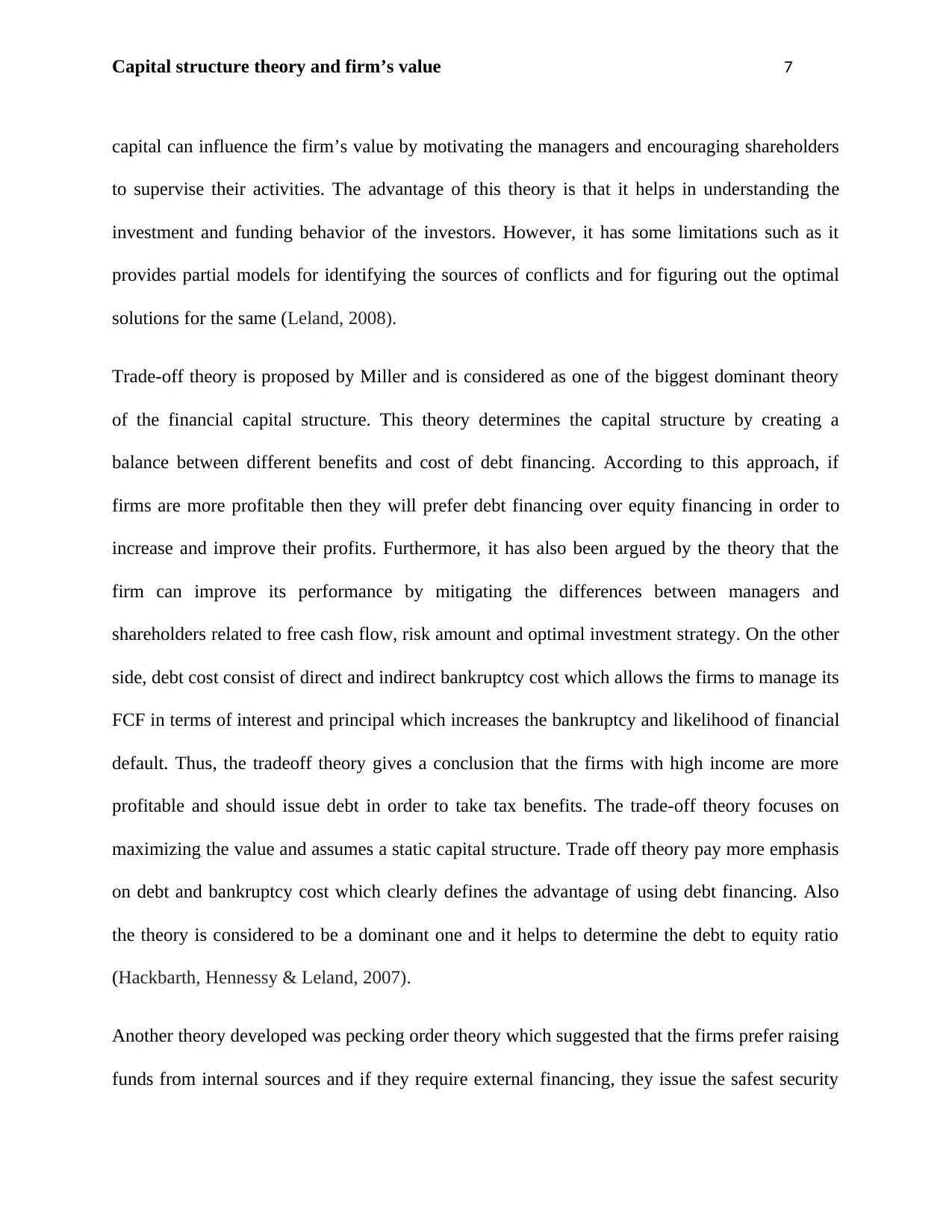
Capital structure theory and firm’s value 7
capital can influence the firm’s value by motivating the managers and encouraging shareholders
to supervise their activities. The advantage of this theory is that it helps in understanding the
investment and funding behavior of the investors. However, it has some limitations such as it
provides partial models for identifying the sources of conflicts and for figuring out the optimal
solutions for the same (Leland, 2008).
Trade-off theory is proposed by Miller and is considered as one of the biggest dominant theory
of the financial capital structure. This theory determines the capital structure by creating a
balance between different benefits and cost of debt financing. According to this approach, if
firms are more profitable then they will prefer debt financing over equity financing in order to
increase and improve their profits. Furthermore, it has also been argued by the theory that the
firm can improve its performance by mitigating the differences between managers and
shareholders related to free cash flow, risk amount and optimal investment strategy. On the other
side, debt cost consist of direct and indirect bankruptcy cost which allows the firms to manage its
FCF in terms of interest and principal which increases the bankruptcy and likelihood of financial
default. Thus, the tradeoff theory gives a conclusion that the firms with high income are more
profitable and should issue debt in order to take tax benefits. The trade-off theory focuses on
maximizing the value and assumes a static capital structure. Trade off theory pay more emphasis
on debt and bankruptcy cost which clearly defines the advantage of using debt financing. Also
the theory is considered to be a dominant one and it helps to determine the debt to equity ratio
(Hackbarth, Hennessy & Leland, 2007).
Another theory developed was pecking order theory which suggested that the firms prefer raising
funds from internal sources and if they require external financing, they issue the safest security
capital can influence the firm’s value by motivating the managers and encouraging shareholders
to supervise their activities. The advantage of this theory is that it helps in understanding the
investment and funding behavior of the investors. However, it has some limitations such as it
provides partial models for identifying the sources of conflicts and for figuring out the optimal
solutions for the same (Leland, 2008).
Trade-off theory is proposed by Miller and is considered as one of the biggest dominant theory
of the financial capital structure. This theory determines the capital structure by creating a
balance between different benefits and cost of debt financing. According to this approach, if
firms are more profitable then they will prefer debt financing over equity financing in order to
increase and improve their profits. Furthermore, it has also been argued by the theory that the
firm can improve its performance by mitigating the differences between managers and
shareholders related to free cash flow, risk amount and optimal investment strategy. On the other
side, debt cost consist of direct and indirect bankruptcy cost which allows the firms to manage its
FCF in terms of interest and principal which increases the bankruptcy and likelihood of financial
default. Thus, the tradeoff theory gives a conclusion that the firms with high income are more
profitable and should issue debt in order to take tax benefits. The trade-off theory focuses on
maximizing the value and assumes a static capital structure. Trade off theory pay more emphasis
on debt and bankruptcy cost which clearly defines the advantage of using debt financing. Also
the theory is considered to be a dominant one and it helps to determine the debt to equity ratio
(Hackbarth, Hennessy & Leland, 2007).
Another theory developed was pecking order theory which suggested that the firms prefer raising
funds from internal sources and if they require external financing, they issue the safest security
Paraphrase This Document
Need a fresh take? Get an instant paraphrase of this document with our AI Paraphraser
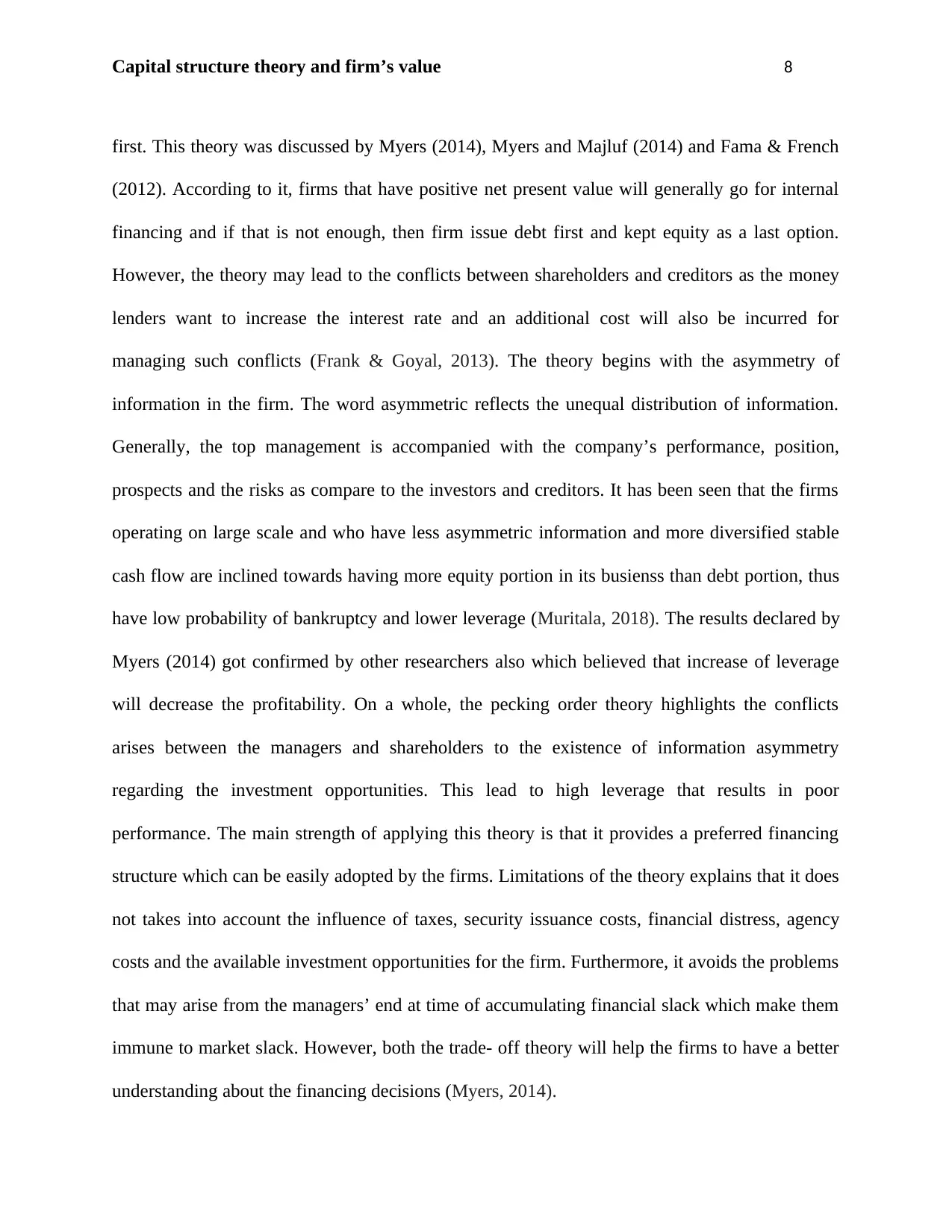
Capital structure theory and firm’s value 8
first. This theory was discussed by Myers (2014), Myers and Majluf (2014) and Fama & French
(2012). According to it, firms that have positive net present value will generally go for internal
financing and if that is not enough, then firm issue debt first and kept equity as a last option.
However, the theory may lead to the conflicts between shareholders and creditors as the money
lenders want to increase the interest rate and an additional cost will also be incurred for
managing such conflicts (Frank & Goyal, 2013). The theory begins with the asymmetry of
information in the firm. The word asymmetric reflects the unequal distribution of information.
Generally, the top management is accompanied with the company’s performance, position,
prospects and the risks as compare to the investors and creditors. It has been seen that the firms
operating on large scale and who have less asymmetric information and more diversified stable
cash flow are inclined towards having more equity portion in its busienss than debt portion, thus
have low probability of bankruptcy and lower leverage (Muritala, 2018). The results declared by
Myers (2014) got confirmed by other researchers also which believed that increase of leverage
will decrease the profitability. On a whole, the pecking order theory highlights the conflicts
arises between the managers and shareholders to the existence of information asymmetry
regarding the investment opportunities. This lead to high leverage that results in poor
performance. The main strength of applying this theory is that it provides a preferred financing
structure which can be easily adopted by the firms. Limitations of the theory explains that it does
not takes into account the influence of taxes, security issuance costs, financial distress, agency
costs and the available investment opportunities for the firm. Furthermore, it avoids the problems
that may arise from the managers’ end at time of accumulating financial slack which make them
immune to market slack. However, both the trade- off theory will help the firms to have a better
understanding about the financing decisions (Myers, 2014).
first. This theory was discussed by Myers (2014), Myers and Majluf (2014) and Fama & French
(2012). According to it, firms that have positive net present value will generally go for internal
financing and if that is not enough, then firm issue debt first and kept equity as a last option.
However, the theory may lead to the conflicts between shareholders and creditors as the money
lenders want to increase the interest rate and an additional cost will also be incurred for
managing such conflicts (Frank & Goyal, 2013). The theory begins with the asymmetry of
information in the firm. The word asymmetric reflects the unequal distribution of information.
Generally, the top management is accompanied with the company’s performance, position,
prospects and the risks as compare to the investors and creditors. It has been seen that the firms
operating on large scale and who have less asymmetric information and more diversified stable
cash flow are inclined towards having more equity portion in its busienss than debt portion, thus
have low probability of bankruptcy and lower leverage (Muritala, 2018). The results declared by
Myers (2014) got confirmed by other researchers also which believed that increase of leverage
will decrease the profitability. On a whole, the pecking order theory highlights the conflicts
arises between the managers and shareholders to the existence of information asymmetry
regarding the investment opportunities. This lead to high leverage that results in poor
performance. The main strength of applying this theory is that it provides a preferred financing
structure which can be easily adopted by the firms. Limitations of the theory explains that it does
not takes into account the influence of taxes, security issuance costs, financial distress, agency
costs and the available investment opportunities for the firm. Furthermore, it avoids the problems
that may arise from the managers’ end at time of accumulating financial slack which make them
immune to market slack. However, both the trade- off theory will help the firms to have a better
understanding about the financing decisions (Myers, 2014).
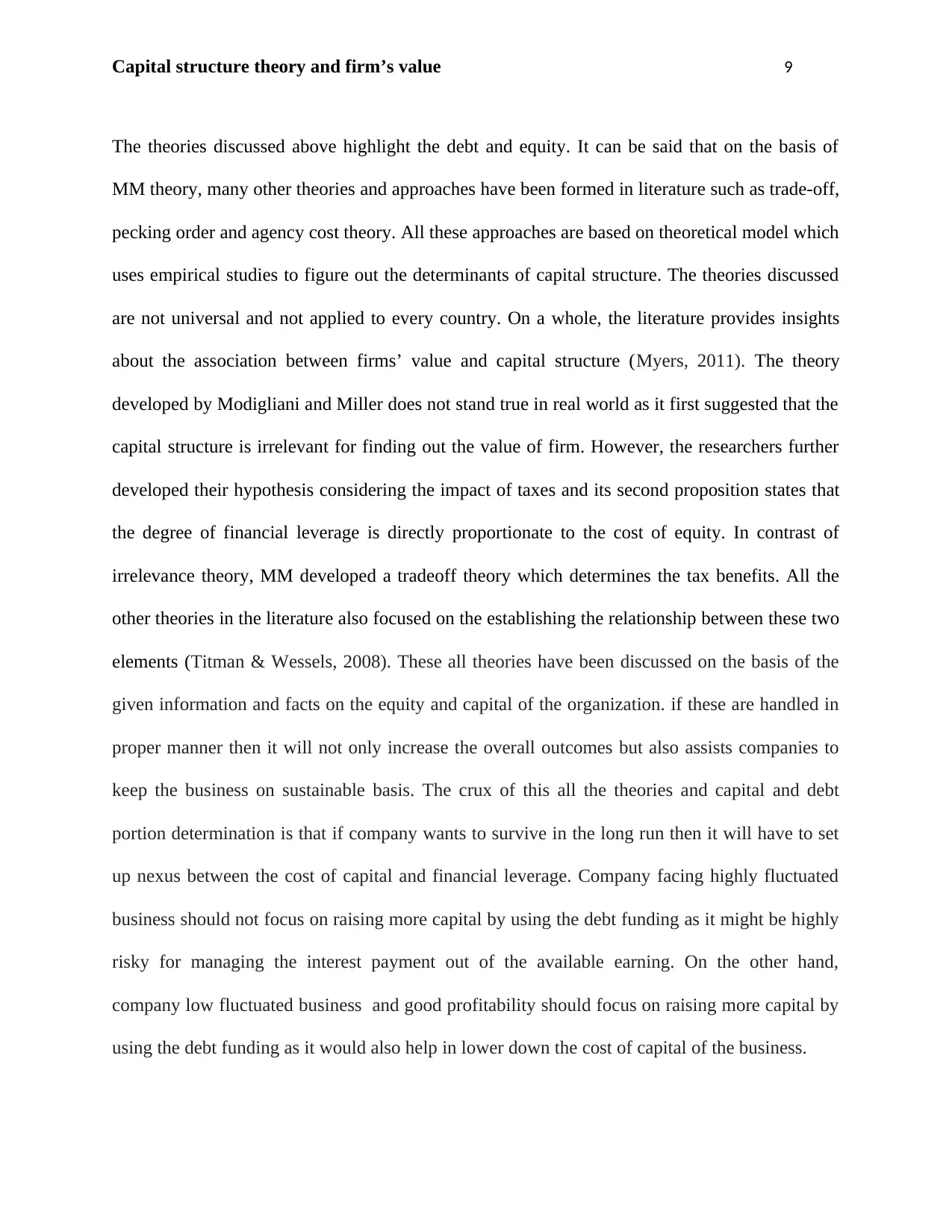
Capital structure theory and firm’s value 9
The theories discussed above highlight the debt and equity. It can be said that on the basis of
MM theory, many other theories and approaches have been formed in literature such as trade-off,
pecking order and agency cost theory. All these approaches are based on theoretical model which
uses empirical studies to figure out the determinants of capital structure. The theories discussed
are not universal and not applied to every country. On a whole, the literature provides insights
about the association between firms’ value and capital structure (Myers, 2011). The theory
developed by Modigliani and Miller does not stand true in real world as it first suggested that the
capital structure is irrelevant for finding out the value of firm. However, the researchers further
developed their hypothesis considering the impact of taxes and its second proposition states that
the degree of financial leverage is directly proportionate to the cost of equity. In contrast of
irrelevance theory, MM developed a tradeoff theory which determines the tax benefits. All the
other theories in the literature also focused on the establishing the relationship between these two
elements (Titman & Wessels, 2008). These all theories have been discussed on the basis of the
given information and facts on the equity and capital of the organization. if these are handled in
proper manner then it will not only increase the overall outcomes but also assists companies to
keep the business on sustainable basis. The crux of this all the theories and capital and debt
portion determination is that if company wants to survive in the long run then it will have to set
up nexus between the cost of capital and financial leverage. Company facing highly fluctuated
business should not focus on raising more capital by using the debt funding as it might be highly
risky for managing the interest payment out of the available earning. On the other hand,
company low fluctuated business and good profitability should focus on raising more capital by
using the debt funding as it would also help in lower down the cost of capital of the business.
The theories discussed above highlight the debt and equity. It can be said that on the basis of
MM theory, many other theories and approaches have been formed in literature such as trade-off,
pecking order and agency cost theory. All these approaches are based on theoretical model which
uses empirical studies to figure out the determinants of capital structure. The theories discussed
are not universal and not applied to every country. On a whole, the literature provides insights
about the association between firms’ value and capital structure (Myers, 2011). The theory
developed by Modigliani and Miller does not stand true in real world as it first suggested that the
capital structure is irrelevant for finding out the value of firm. However, the researchers further
developed their hypothesis considering the impact of taxes and its second proposition states that
the degree of financial leverage is directly proportionate to the cost of equity. In contrast of
irrelevance theory, MM developed a tradeoff theory which determines the tax benefits. All the
other theories in the literature also focused on the establishing the relationship between these two
elements (Titman & Wessels, 2008). These all theories have been discussed on the basis of the
given information and facts on the equity and capital of the organization. if these are handled in
proper manner then it will not only increase the overall outcomes but also assists companies to
keep the business on sustainable basis. The crux of this all the theories and capital and debt
portion determination is that if company wants to survive in the long run then it will have to set
up nexus between the cost of capital and financial leverage. Company facing highly fluctuated
business should not focus on raising more capital by using the debt funding as it might be highly
risky for managing the interest payment out of the available earning. On the other hand,
company low fluctuated business and good profitability should focus on raising more capital by
using the debt funding as it would also help in lower down the cost of capital of the business.
⊘ This is a preview!⊘
Do you want full access?
Subscribe today to unlock all pages.

Trusted by 1+ million students worldwide

Capital structure theory and firm’s value 10
References
Berger, A. N., & Di Patti, E. B. (2016). Capital structure and firm performance: A new approach
to testing agency theory and an application to the banking industry. Journal of Banking &
Finance, 30(4), 1065-1102.
Berk, J., DeMarzo, P., Harford, J., Ford, G., Mollica, V., & Finch, N. (2013). Fundamentals of
corporate finance. Australia: Pearson Higher Education AU.
Frank, M. Z., & Goyal, V. K. (2003). Testing the pecking order theory of capital
structure. Journal of financial economics, 67(2), 217-248.
Gitman, L. J., Juchau, R., & Flanagan, J. (2015). Principles of managerial finance. Australia:
Pearson Higher Education AU.
Hackbarth, D., Hennessy, C. A., & Leland, H. E. (2007). Can the trade-off theory explain debt
structure?. The Review of Financial Studies, 20(5), 1389-1428.
Harris, M., & Raviv, A. (2011). The theory of capital structure. the Journal of Finance, 46(1),
297-355.
Leland, H. E. (2014). Agency costs, risk management, and capital structure. The Journal of
Finance, 53(4), 1213-1243.
Muritala, T. A. (2018). An empirical analysis of capital structure on firms’ performance in
Nigeria. IJAME.
Myers, S. C. (2014). The capital structure puzzle. The journal of finance, 39(3), 574-592.
References
Berger, A. N., & Di Patti, E. B. (2016). Capital structure and firm performance: A new approach
to testing agency theory and an application to the banking industry. Journal of Banking &
Finance, 30(4), 1065-1102.
Berk, J., DeMarzo, P., Harford, J., Ford, G., Mollica, V., & Finch, N. (2013). Fundamentals of
corporate finance. Australia: Pearson Higher Education AU.
Frank, M. Z., & Goyal, V. K. (2003). Testing the pecking order theory of capital
structure. Journal of financial economics, 67(2), 217-248.
Gitman, L. J., Juchau, R., & Flanagan, J. (2015). Principles of managerial finance. Australia:
Pearson Higher Education AU.
Hackbarth, D., Hennessy, C. A., & Leland, H. E. (2007). Can the trade-off theory explain debt
structure?. The Review of Financial Studies, 20(5), 1389-1428.
Harris, M., & Raviv, A. (2011). The theory of capital structure. the Journal of Finance, 46(1),
297-355.
Leland, H. E. (2014). Agency costs, risk management, and capital structure. The Journal of
Finance, 53(4), 1213-1243.
Muritala, T. A. (2018). An empirical analysis of capital structure on firms’ performance in
Nigeria. IJAME.
Myers, S. C. (2014). The capital structure puzzle. The journal of finance, 39(3), 574-592.
Paraphrase This Document
Need a fresh take? Get an instant paraphrase of this document with our AI Paraphraser
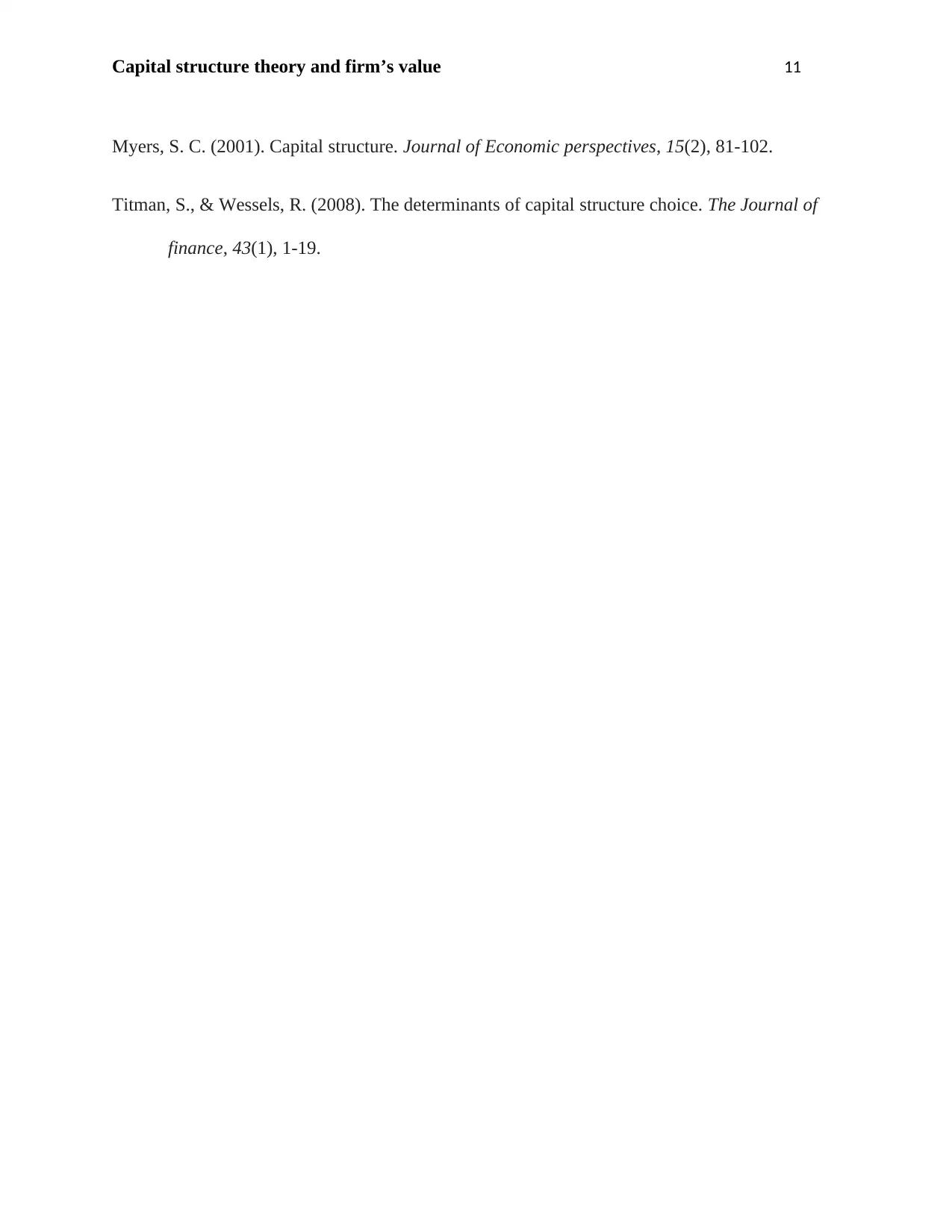
Capital structure theory and firm’s value 11
Myers, S. C. (2001). Capital structure. Journal of Economic perspectives, 15(2), 81-102.
Titman, S., & Wessels, R. (2008). The determinants of capital structure choice. The Journal of
finance, 43(1), 1-19.
Myers, S. C. (2001). Capital structure. Journal of Economic perspectives, 15(2), 81-102.
Titman, S., & Wessels, R. (2008). The determinants of capital structure choice. The Journal of
finance, 43(1), 1-19.
1 out of 11
Related Documents
Your All-in-One AI-Powered Toolkit for Academic Success.
+13062052269
info@desklib.com
Available 24*7 on WhatsApp / Email
![[object Object]](/_next/static/media/star-bottom.7253800d.svg)
Unlock your academic potential
Copyright © 2020–2025 A2Z Services. All Rights Reserved. Developed and managed by ZUCOL.





